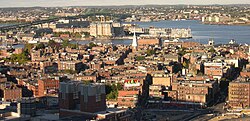Old North Church
|
Old North Church
|
|

Image of the North End, Boston neighborhood. The Old North Church is at center, a Big Dig vent building is near the bottom, and the green Tobin Bridge over the Mystic River is at the top.
|
|
| Location | Boston, MA |
|---|---|
| Coordinates | 42°21′58.78″N 71°3′16.04″W / 42.3663278°N 71.0544556°WCoordinates: 42°21′58.78″N 71°3′16.04″W / 42.3663278°N 71.0544556°W |
| Built | 1723 |
| Architect | Price, William |
| Architectural style | Georgian |
| NRHP Reference # | |
| Significant dates | |
| Added to NRHP | October 15, 1966 |
| Designated NHL | January 20, 1961 |
Old North Church (officially, Christ Church in the City of Boston), at 193 Salem Street, in the North End of Boston, is the location from which the famous "One if by land, and two if by sea" signal is said to have been sent. This phrase is related to Paul Revere's midnight ride, of April 18, 1775, which preceded the Battles of Lexington and Concord during the American Revolution.
The church is a mission of the Episcopal Diocese of Massachusetts. It is the oldest standing church building in Boston and is a National Historic Landmark. Inside the church is a bust of George Washington, which the Marquis de Lafayette reportedly remarked was the best likeness of the first president he had ever seen.
The Old North Church was built in December, 1723, and was inspired by the works of Christopher Wren, the British architect who was responsible for rebuilding London after the Great Fire. Timothy Cutler was the founding rector after serving as third rector of Yale College from 1719 to 1722.
In April 1775, Paul Revere told three Boston patriots to hang two lanterns in the steeple. These men were the church sexton Robert Newman and Captain John Pulling—the two of whom historian David Hackett Fischer suggests each carried one lantern up to the steeple—as well as Thomas Bernard, who stood watch for British troops outside the church. The lanterns were displayed to send a warning to Charlestown patriots across the Charles River about the movements of the British Army. Revere and William Dawes would later deliver the same message to Lexington themselves, but this lantern method was a fast way to inform the back-up riders in Charlestown about the movements of the British; these back-up riders planned to deliver the warning message to Lexington and Concord in case Revere and Dawes were arrested on the way.
...
Wikipedia
